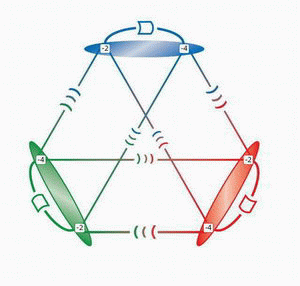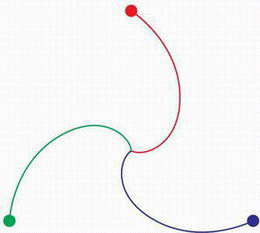April 17, 2007 feature
Mathematician suggests extra dimensions are time-like

In a recent study, mathematician George Sparling of the University of Pittsburgh examines a fundamental question pondered since the time of Pythagoras, and still vexing scientists today: what is the nature of space and time? After analyzing different perspectives, Sparling offers an alternative idea: space-time may have six dimensions, with the extra two being time-like.
Sparling’s paper, which was published in the Proceedings of the Royal Society A, lays the groundwork for his theory. He explains how spatial dimensions contain positive signs (e.g., Pythagoras’ 3D space is expressed as the sum of the squares of the intervals in three directions, x, y, and z). Minkowski’s time-like dimension, on the other hand, combines these three dimensions with the square of time displacement, which contains an overall negative sign.
“In three dimensions, the formula reads s2 = x2 + y2 + z2,” Sparling explained to PhysOrg.com. “Our standard spacetime has four dimensions, but the formula has a critical minus sign: s2 = x2 + y2 + z2 - t2. The Lithuanian Hermann Minkowski invented this idea, which was published just six weeks before he died. Indeed, [Sir Roger] Penrose, for one, says that special relativity was not a finished theory until Minkowski's famous Raum und Zeit [‘Space and Time’] paper.”
Up until now, Sparling explains, most theories concerning extra dimensions have dealt with space-like rather than time-like dimensions, which results in a “hyperbolic” rather than an “ultra-hyperbolic” geometry. However, Sparling notes that there are no a priori arguments for a hyperbolic geometry, and he looks into the possibility of a “spinorial” theory of physics, where six dimensions of space-time arise naturally.
“In general dimensions, we say that the space-time is hyperbolic if there is only one minus sign in the formula for s2,” he said. “So, for example, in the ten dimensions of superstring theory, there are nine spatial dimensions with plus signs and one minus sign. Only in that situation is there a clear-cut distinction between the future and the past.”

“In my case, I am led to the conclusion that the ordinary four dimensional space-time extends naturally into six dimensions: the four dimensional space is hyperbolic as usual, but in the surrounding space there are equal numbers (3 each) of space and time dimensions, so the formula for s2 reads something like s2 = x2 + y2 + z2 - t2 - u2 - v2, where u and v represent the new time variables. I call this structure a (3, 3)-structure (mathematicians call it ultra-hyperbolic).”
Space-Time is Spinorial
Sparling’s spinorial theory is based on Einstein’s general relativity and Elie Cartan’s triality concept, which can link space-time with two twistor spaces. Twistor spaces are mathematical spaces used to understand geometrical objects in space-time landscapes. Sparling explains spinors in the following way:
“In physics, the idea of a spinor stems from the finding that spectral lines of atoms seem to behave as if the angular momentum of the particles radiating photons was in half-integral units of the quantized spin (whose size is determined by Planck's constant). This was fully explained by Dirac's famous theory of the electron, which led him to successfully predict the existence of the positron.”
Some spinorial particles include the electron, muon, tau, proton, neutron, quarks, neutrinos, and all their anti-particles, which are called fermions and have half-integer spins. There are also non-spinorial particles, called bosons, such as the photon, graviton, pion, mesons, the W and Z bosons, the Higgs, (if it exists) and so on, which have an integer spin, Sparling explains.
“The key difference between spinors and non-spinors is their behavior under rotations: typically, non-spinorial (integer-spin) particles return to their initial value under a 360-degree (or 2π-radian) rotation; however, the spinorial (half-integer-spin) fermions actually change sign under a 360-degree rotation, requiring a full 720-degree rotation to get back to their initial values. This is completely foreign to our naive idea of how rotations work, and yet it is a basic part of reality.
“Consider this analogy: if you take a plate and hold it in one hand horizontally whilst twisting it under your arm backwards through 360 degrees, your arm ends up in the air after one rotation, and it needs another 360 degree rotation to get it back to the beginning,” he said.
Twistors, then, are a special kind of spinor first introduced by Penrose (Sparling was a PhD student of Penrose). In Sparling’s theory, the two twistor spaces are each six-dimensional, forcing space-time to also have six dimensions, in accordance with Cartan’s unifying triality. Because the twistor spaces’ geometry is ultra-hyperbolic, the extra dimensions are time-like.
“My work has three six-dimensional spaces which at one level are on an equal footing and which are bound together by a new transform, which I call the Xi-transform,” Sparling said. “Two of these spaces can be understood at the space-time level as twisters. Then the third space can be given a space-time interpretation, but only if we have two extra dimensions: so it is the requirement of symmetry between the spinor spaces and the space-time that dictates that the extra dimensions be there.”
A Harmonious Concinnity
While the concepts of twistor theory and spinors have been previously investigated as an alternative to space-time, Sparling explains how his new proposal is slightly different because it’s not a complete replacement of space-time. Rather, the guiding principle of his idea is that of a harmonious combination of three entities, or a “trinity.” Each part of the theory reinforces the other parts.
“If one accepts that there are these three spaces [space-time and two twistor spaces] that are central to my theory, one looks for a theory which unifies them; this would be the ‘concinnity’,” he explained. “An indicator that there might be such a theory comes from the theory of Jordan algebras, which naturally unifies the three spaces into a twenty-seven dimensional whole, called an exceptional Jordan algebra.” Sparling’s student Philip Tillman and ex-students Dana Mihai, Devendra Kapadia and Suresh Maran also played a significant role related to this work.
“A second indicator is that there are two radically different descriptions of massless particles, such as the photon: the standard one uses Fourier analysis in space-time and another uses twistor theory and sheaf cohomology,” he added. “The mathematical formalisms used in these two different descriptions are so different that it is simply amazing that they are describing the same basic physics. The concinnity would provide an explanation for this. This would then unify twistor theory, space-time theory and string theory—this is very tentative, however.
“A very interesting aspect is that Newton fought strongly against the idea of the trinity (in a religious context),” Sparling noted. “It is ironic that I am invoking that very same idea in the context of gravity: perhaps Newton saw that the concept could be used in physics, but because he could not think of such a use he rebelled strongly against it (of course, I have no evidence for this!).”
Although the theory is not definitive, Sparling explains that several major ideas in current physics would likely play a role (such as condensed matter physics, category theory, non-commutative geometry, string theory, and the structure of superfluids). Such connections might also point the direction to a unified theory, though currently speculative.
“My work can be seen as a strong antidote to the present air of pessimism surrounding modern fundamental physics,” Sparling said. “As is well-known, string theory has been roundly criticized for its lack of predictive power. String theorists have been reduced to an absurd reliance on the anthropic principle, for example. Here I have a clear-cut prediction, which goes against the common wisdom, which gives experimenters a target to go for: first find the extra dimensions, then decide their signature (a very tough homework assignment!). Of course I could be proved wrong, but the effort to decide is surely worthwhile.
“Actually, in the area of philosophy, I am in opposition to string theory,” he said. “It is a top down theory: dream up something that works in some high dimension and then try to finagle some way of reducing to fit in with the lower-dimensional theory. My approach is bottom up: take the existing four-dimensional theory seriously and try to build up from it. This is very tough to do. Hopefully my ideas work. Note that my work only constitutes a possible beginning at a more inclusive theory.”
Sparling continues to explore the ideas of this 6-D time-like spinorial theory of space-time, with support from a workshop at the BIRS Institute in Banff, Canada, and ideas from philosophers including Alexander Afriat, Steve Awodey, Jonathan Bain and Rita Marija Malikonyte-Mockus. He predicts that experimental investigations in the near future—such as the Large Hadron Collider—might uncover the extra dimensions.
Citation: Sparling, George A. J. “Germ of a synthesis: space-time is spinorial, extra dimensions are time-like.” Proc. R. Soc. A. doi:10.1098/rspa.2007.1839.
Copyright 2007 PhysOrg.com.
All rights reserved. This material may not be published, broadcast, rewritten or redistributed in whole or part without the express written permission of PhysOrg.com.





















